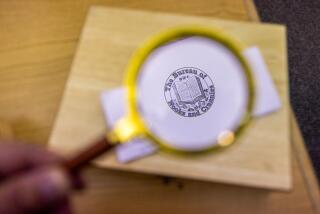Huntington Library: Orderly Chaos but a Researcherâs Delight
There is more than one way to impose order on chaos.
Lida Bushloper knows that now, having worked six years in the rare book stacks at the Huntington Library in San Marino, one of the best respected and most peculiarly organized book collections in the world.
There, half a million rare and reference books are shelved under 500 categories, some of them downright quirky. Some books are grouped by author and subject. But according to Huntington tradition, many others are sorted by size, age, value, type of binding--even by the names of their illustrators or their previous owners.
Say you are seeking Mark Twainâs signed copy, bound in leather, of a 16th-Century printed book about America. In this libraryâs cool, dehumidified stacks, that volume could be found either among books Twain owned, finely bound books, 16th-Century books or early books about America. If it was especially rare, it would be somewhere else altogether.
Bushloper, the stacks supervisor, is impressive in the face of such a challenge. Give her 10 minutes, and she can usually put her hands on any one of the collectionâs 500,000 offerings. The system works, she says, once you get to know it.
âBasically, you have to be a little old man whoâs worked here for 80 years to find anything,â she said.
Each year, more than half a million people visit the Huntington Library, Art Collections and Botanical Gardens. Some are drawn by the impish gaze of âBlue Boy,â Thomas Gainsboroughâs famous painting. Others travel for miles to stroll among the roses, the camellias and the cacti.
But a smaller, select group--fewer than 2,000 a year--come to read. Shakespearean scholars and screenplay writers, historians and archeologists, they arrive early each morning except Sunday, stepping out of the bright sunshine into the research libraryâs hushed, windowless reading room.
It is not open to everyone--researchers must prove the merits of their projects before being made âreadersâ and given access to Wallace Stevensâ handwritten letters, or George Washingtonâs copy of Homerâs âThe Odysseyâ or the reward poster, dated 1865, offering $100,000 for the capture of Abraham Lincolnâs assassin.
They must also follow the rules. Ink pens--whose stain, even in careful hands, can scar the printed page--are forbidden. Books are, literally, put on pedestals: V-shaped cradles that guard against broken bindings.
Readers must submit written requests to Bushloper and her colleagues to obtain the materials they seek. It is up to them--âPedants,â says Bushloper, âand incurable bibliophilesâ--to fulfill the libraryâs mandate, uniting readers with the precious volumes, manuscripts, photographs and prints of Henry Edwards Huntington.
Huntingtonâs library arrived in Southern California by train in 1920, but not without creating a stir.
In the short space of a decade, the railroad magnate had become known as Americaâs outstanding book collector, assembling a formidable library of British and American history and literature in his New York home. So when he decided to move his collection to San Marino, 11 miles from downtown Los Angeles, and open it to the public, East Coast scholars were aghast.
Huntingtonâs books, they said, would surely be better appreciated--and more frequently used--on the learned Atlantic Coast than in the rugged West. And at the time, historians say, those scholars were probably right.
But Huntington had confidence in the future of Southern California. He had had a part in its growth, consolidating and expanding Los Angelesâ rail lines during the early 1900s and, coincidentally, falling in love with the lush San Marino Ranch that houses the library today.
âThis is like heaven to me,â he was heard to say. When asked if he ever planned to write an autobiography, Huntington said no. âThis library,â he said, âwill tell the story.â
The library, of course, tells many stories, and not just the big name sagas. In addition to a Gutenberg Bible on vellum, it has the pulp classics âPanther Paul, the Prairie Pirateâ and âDaddy Dead-Eye, The Despot of Dew-Dropâ--two from a collection of several hundred 19th-Century dime novels.
Then there is the ephemera--the stuff that was meant to be thrown away. The library has a bunch of it, from ballots to bus tickets to buttons, from Christmas cards to valentines.
Cathy Cherbosque is the curator who presides over this oddball accumulation--a collection so idiosyncratic that library director William A. Moffett calls it the Huntingtonâs attic. It is a testament to the power of the pack rat.
âEveryone collects something,â Cherbosque said as she poked through the embossed envelopes, the playbills and the scrapbooks. âIt wasnât meant to be kept, but through the stubbornness of somebody, it was.â
There is an advertisement, circa 1887, for Merchantâs Gargling Oil, a liniment for man and beast. A monkey pictured applying the oil speaks in rhyme: âIf I am Darwinâs Grandpapa It Follows, Donât You See, That What is Good for Man & Beast Is Doubly Good For Me.â
There is a 1938 menu from Bobâs Restaurant of Glendale, Eagle Rock and Burbank. âFamous,â the menu proclaims, âfor Chili-Steaks, Thick Shakes, Thin Pancakes.â
Of all the stuff, only about one-tenth has yet been catalogued--the menus, the citrus labels, the trading cards. The rest is neatly but haphazardly shelved: the campaign posters next to the playing cards, the bookmarks nestled in with the bronze medals.
âYou have to try to impose some order,â said Cherbosque, sighing as she contemplated the magnitude of that job. âYou know what disarray can happen with your own things that you save? Well, multiply that by 1,000.â
More to Read
Sign up for our Book Club newsletter
Get the latest news, events and more from the Los Angeles Times Book Club, and help us get L.A. reading and talking.
You may occasionally receive promotional content from the Los Angeles Times.








